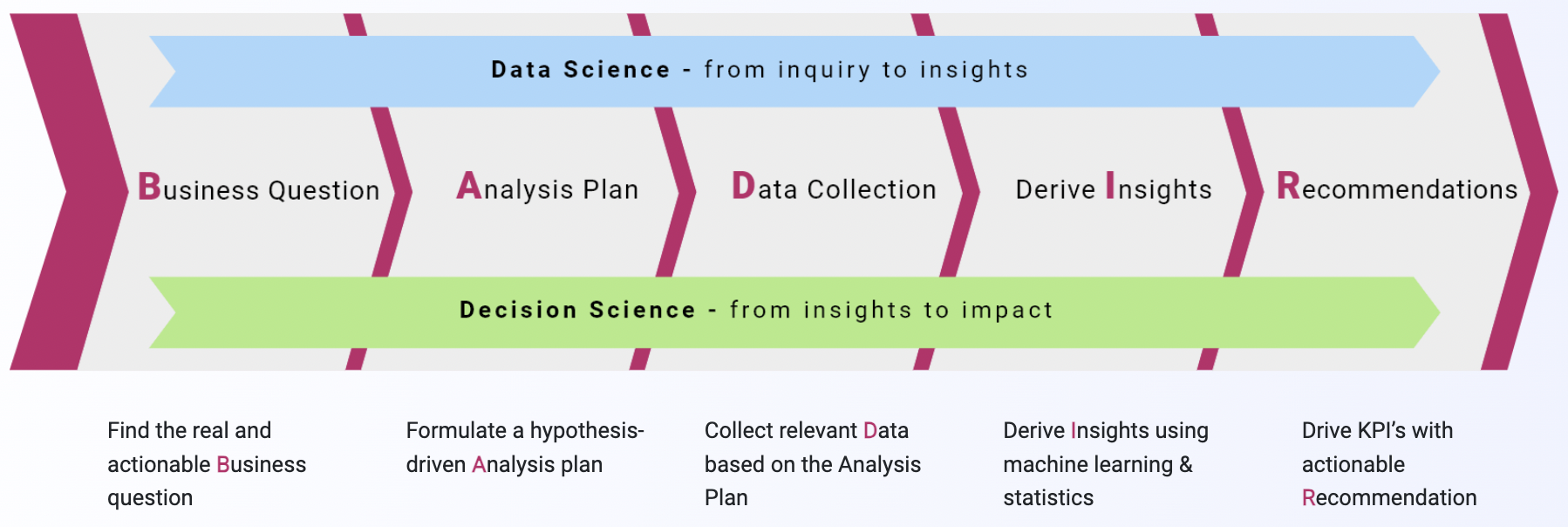In today’s business environment, the decision-making process is often a critical point of failure, holding back organizations from realizing their full potential. When the issue lies not in the lack of data but in how it’s used – or not used – in decision-making, how can data leaders spotlight this gap and guide the organization toward more effective practices?
To get started, here are a two very real examples:
A team composed of Product and Marketing was at a crossroads, trying to decide whether to invest in Campaign A, with a 46% conversion rate and 21,000 conversions, or Campaign B, with a 38% rate but 74,000 conversions.
A team composed of Product, Engineering, and Operations struggled to decide how to turn around a sudden 4% drop in sales that occurred at the same time new features were released and Operations reported a 16% increase in customer support calls.
Data informed decisions are when people act as though the data will tell them what to do. As shown in these two cases.
Data-driven decisions are made when the appropriate analysis is done to quickly understand what the data means and how it backs up recommendations that are in line with their business goal or objective.
The Cost of Ineffective Decision-Making
We have all experienced ineffective decision-making. Endless meetings without resolutions, deferred or avoided decisions, poor choices, and a general level of frustration with other decision-makers. These are telltale signs of this systemic issue. The cost? A staggering estimated $250 million annually in lost opportunities and 500,000 hours wasted in meetings, and as much as 3% of profits.
Data-Informed vs. Data-Driven
A problem we most often see is that the decision-making process and the data analytics process are treated as separate. Or, at best, the data analytics process is sandwiched between a business problem and a presentation of the data.
When the data team starts to engage with business stakeholders or teams, we encourage them to ask, “How will the data be used?” and, “What is the problem you are trying to solve?”.
Another best practice is to ask “What decisions do you need to make with the data and how will you make them, and when?”.
This leads to an understanding of who will make the decisions, aka who is impacted by them. It gives the data team the chance to see who should be involved from the start. If the right people are not involved, we often see the data used for cross-functional finger pointing. This leads to conflict or resistence to solutions, and the data team can get caught in the crossfire!
If we can get people and the data-driven decision-making process in sync, we can unblock the human barriers to getting value from our data.
Becoming data-driven in Three Steps:
1. Alignment: The first step involves aligning leadership with key Performance Indicators (KPIs) and their drivers. Many leaders start here but fail to get the full benefits from a decision-making standpoint. They do not look at drivers and size the potential impacts of each one before acting. A sizing framework is invaluable here, helping leaders to pinpoint opportunities for business growth and align efforts with strategic goals. We use a routine called “Three Key Questions” that is highly effective in bringing out the relevant data. This technique also helps leaders see data as boundaryless. If KPIs are looked at from a functional perspective it may dilute the value it can have on business performance.
2. Prioritization: Beyond dashboards and status updates, leaders need actionable insights. With a robust KPI measurement framework, it becomes possible to prioritize projects or use-cases based on their quantified potential impact. This approach involves setting clear goals and regularly reviewing progress, focusing on outcomes rather than just activities. For example, one leadership team took their KPI on Revenue Growth, measured drivers, and they were able to immediately see the top three drivers that could potentially impact 80%+ of the projected growth target. These became the projects for the next quarter. With fewer concurrent projects, the leadership team was in a position to get faster results in a matter of a few months, not quarters.
3. Process: When the expectation is to find and deliver value through data, it helps to combine business decision making process and data analytics process. One framework which seamlessly combines them is B.A.D.I.R. It uses specific techniques that guide the team, stakeholders, and data experts in a collaborative interaction versus a handover.

This is where there is the biggest opportunity for efficiency and ROI. Leaders align on top KPIs and prioritize top use cases based on potential impact. The BADIR process combines data analytics and decision-making to streamline the proper level of analysis and enables efficiency.
Conclusion
Because I am a people-process-data geek, I appreciate what J. Edward Deming said many years ago, “94% of problems are caused by the system.” But in the world today, where we are more and more knowledge workers, our processes drive behaviors (and vice-versa!). It is impossible to separate people and process. Deming also said, “if you can’t describe what you are doing as a process, you don’t know what you are doing”. Decision making is a completely human activity that is done with other humans. But it can be described in the context of a data-driven process. It is up to us as leaders to champion a clear data driven decision making process that can scale up effective collaborative behaviors, a sense of shared goals, and leads to real business results.
Authored by Susan Stocker

Add a Comment